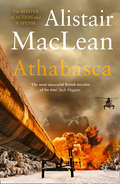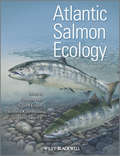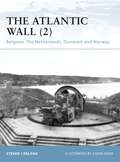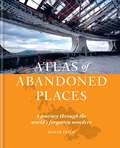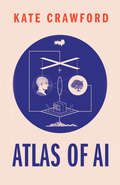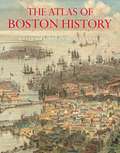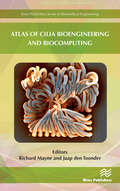- Table View
- List View
Athabasca: Night Without End, Ice Station Zebra, Bear Island, Athabasca
by Alistair MacLeanThe nail-biting tale of sabotage set in the desolate frozen wastes of two ice-bound oil fields, from the acclaimed master of action and suspense.
Atlantic Automobilism: Emergence and Persistence of the Car, 1895-1940 (Explorations in Mobility #1)
by Gijs MomOur continued use of the combustion engine car in the 21st century, despite many rational arguments against it, makes it more and more difficult to imagine that transport has a sustainable future. Offering a sweeping transatlantic perspective, this book explains the current obsession with automobiles by delving deep into the motives of early car users. It provides a synthesis of our knowledge about the emergence and persistence of the car, using a broad range of material including novels, poems, films, and songs to unearth the desires that shaped our present “car society.” Combining social, psychological, and structural explanations, the author concludes that the ability of cars to convey transcendental experience, especially for men, explains our attachment to the vehicle.
Atlantic Automobilism: Emergence and Persistence of the Car, 1895-1940 (Explorations in Mobility #1)
by Gijs MomOur continued use of the combustion engine car in the 21st century, despite many rational arguments against it, makes it more and more difficult to imagine that transport has a sustainable future. Offering a sweeping transatlantic perspective, this book explains the current obsession with automobiles by delving deep into the motives of early car users. It provides a synthesis of our knowledge about the emergence and persistence of the car, using a broad range of material including novels, poems, films, and songs to unearth the desires that shaped our present “car society.” Combining social, psychological, and structural explanations, the author concludes that the ability of cars to convey transcendental experience, especially for men, explains our attachment to the vehicle.
Atlantic Cod: A Bio-Ecology
by George RoseA comprehensive handbook, covering all aspects of the Atlantic cod including the biology, ecology, life histories, behaviour, commercial exploitation and conservation Not only is Atlantic cod one of the most valuable food fish in the world’s oceans, it is an important component of North Atlantic ecosystems and has been subject to much research into its biology, ecology and exploitation. After hundreds of years of exploitation, overfishing in the last half of the 20th Century caused many stocks to collapse, most famously the Northern cod stock off Newfoundland and Labrador, Canada. Since then, most cod stocks have been better researched and managed, but remain in a variety of states, from fully recovered to continued decline. This book, written by world experts, describes that research and management, and the importance of cod and its fisheries on North Atlantic cultures and economies, with impacts well beyond the range of the species. Atlantic Cod: Bio-Ecology of the Fish offers insightful chapter coverage of cod nomenclature, taxonomy, phylogeny and morphology; physiology and ecophysiology; reproduction and spawning behavior; early life history and pre-recruitment processes; migrations, movements and stock identity; feeding, growth and energetics; the place of cod in the ecosystem; the exploitation of cod through history and present day commercial fisheries and precautionary management for sustainable fisheries; impacts of climate change on cod biology and ecology; and the future of the species and its fisheries. Discusses the major commercial importance of Atlantic cod through history Provides a comprehensive treatment of the bio-ecology of the most researched and highly exploited fully marine species Examines how the decline (and recovery) of cod stocks is of great political and scientific interest An essential purchase for marine fisheries scientists Atlantic Cod: Bio-Ecology of the Fish is a vital book for all fisheries scientists, managers and fish biologists.
Atlantic Cod: A Bio-Ecology
by George A. RoseA comprehensive handbook, covering all aspects of the Atlantic cod including the biology, ecology, life histories, behaviour, commercial exploitation and conservation Not only is Atlantic cod one of the most valuable food fish in the world’s oceans, it is an important component of North Atlantic ecosystems and has been subject to much research into its biology, ecology and exploitation. After hundreds of years of exploitation, overfishing in the last half of the 20th Century caused many stocks to collapse, most famously the Northern cod stock off Newfoundland and Labrador, Canada. Since then, most cod stocks have been better researched and managed, but remain in a variety of states, from fully recovered to continued decline. This book, written by world experts, describes that research and management, and the importance of cod and its fisheries on North Atlantic cultures and economies, with impacts well beyond the range of the species. Atlantic Cod: Bio-Ecology of the Fish offers insightful chapter coverage of cod nomenclature, taxonomy, phylogeny and morphology; physiology and ecophysiology; reproduction and spawning behavior; early life history and pre-recruitment processes; migrations, movements and stock identity; feeding, growth and energetics; the place of cod in the ecosystem; the exploitation of cod through history and present day commercial fisheries and precautionary management for sustainable fisheries; impacts of climate change on cod biology and ecology; and the future of the species and its fisheries. Discusses the major commercial importance of Atlantic cod through history Provides a comprehensive treatment of the bio-ecology of the most researched and highly exploited fully marine species Examines how the decline (and recovery) of cod stocks is of great political and scientific interest An essential purchase for marine fisheries scientists Atlantic Cod: Bio-Ecology of the Fish is a vital book for all fisheries scientists, managers and fish biologists.
The Atlantic Salmon: Genetics, Conservation and Management
by Eric Verspoor Lee Stradmeyer Jennifer L. NielsenAtlantic Salmon is a cultural icon throughout its North Atlantic range; it is the focus of probably the World’s highest profile recreational fishery and is the basis for one of the World’s largest aquaculture industries. Despite this, many wild stocks of salmon are in decline and underpinning this is a dearth of information on the nature and extent of population structuring and adaptive population differentiation, and its implications for species conservation. This important new book will go a long way to rectify this situation by providing a thorough review of the genetics of Atlantic salmon. Sponsored by the European Union and the Atlantic Salmon Trust, this book comprises the work of an international team of scientists, carefully integrated and edited to provide a landmark book of vital interest to all those working with Atlantic salmon.
Atlantic Salmon Ecology
by Øystein Aas Sigurd Einum Anders Klemetsen Jostein SkurdalThe Atlantic salmon is one of the most prized and exploited species worldwide, being at the centre of a massive sports fishing industry and increasingly as the major farmed species in many countries worldwide. Atlantic Salmon Ecology is a landmark publication, both scientifically important and visually attractive. Comprehensively covering all major aspects of the relationship of the Atlantic salmon with its environment, chapters include details of migration and dispersal, reproduction, habitat requirements, feeding, growth rates, competition, predation, parasitsm, population dynamics, effects of landscape use, hydro power development, climate change, and exploitation. The book closes with a summary and look at possible future research directions. Backed by the Norwegian Research Council and with editors and contributors widely known and respected, Atlantic Salmon Ecology is an essential purchase for all those working with this species, including fisheries scientists and managers, fish biologists, ecologists, physiologists, environmental biologists and aquatic scientists, fish and wildlife department personnel and regulatory bodies. Libraries in all universities and research establishments where these subjects are studied and taught should have copies of this important publication. Comprehensive and up-to-date coverage of Atlantic Salmon Atlantic Salmon is one of the world's most commercially important species Backed by the Norwegian Research Council Experienced editor and internationally respected contributors
Atlantic Salmon Ecology
by Sigurd Einum Anders Klemetsen Jostein Skurdal Øystein AasThe Atlantic salmon is one of the most prized and exploited species worldwide, being at the centre of a massive sports fishing industry and increasingly as the major farmed species in many countries worldwide. Atlantic Salmon Ecology is a landmark publication, both scientifically important and visually attractive. Comprehensively covering all major aspects of the relationship of the Atlantic salmon with its environment, chapters include details of migration and dispersal, reproduction, habitat requirements, feeding, growth rates, competition, predation, parasitsm, population dynamics, effects of landscape use, hydro power development, climate change, and exploitation. The book closes with a summary and look at possible future research directions. Backed by the Norwegian Research Council and with editors and contributors widely known and respected, Atlantic Salmon Ecology is an essential purchase for all those working with this species, including fisheries scientists and managers, fish biologists, ecologists, physiologists, environmental biologists and aquatic scientists, fish and wildlife department personnel and regulatory bodies. Libraries in all universities and research establishments where these subjects are studied and taught should have copies of this important publication. Comprehensive and up-to-date coverage of Atlantic Salmon Atlantic Salmon is one of the world's most commercially important species Backed by the Norwegian Research Council Experienced editor and internationally respected contributors
The Atlantic Wall: Belgium, The Netherlands, Denmark and Norway (Fortress #89)
by Steven J. ZalogaGermany's Atlantic Wall was the most ambitious military fortification program of World War II. Following its conquest of Western Europe, Germany had to defend some 5,000km of Atlantic coastline from the Spanish border to the Arctic Circle. The United States' entry into the war and the inevitability of an Anglo-American landing in Western Europe resulted in the fortification of this coastline along its entire length. Focusing on the northern Atlantic Wall in the Low Countries and Scandinavia, this title addresses the special defensive features and unique aspects of fortification in these countries, such as the early focus on fortifying Norway, due to early British commando raids; the greater use of turreted naval guns; and the establishment of first-line Flak defences in the Low Countries to counter the Allied strategic bombing campaign.
The Atlantic Wall: Belgium, The Netherlands, Denmark and Norway (Fortress #89)
by Steven J. Zaloga Adam HookGermany's Atlantic Wall was the most ambitious military fortification program of World War II. Following its conquest of Western Europe, Germany had to defend some 5,000km of Atlantic coastline from the Spanish border to the Arctic Circle. The United States' entry into the war and the inevitability of an Anglo-American landing in Western Europe resulted in the fortification of this coastline along its entire length. Focusing on the northern Atlantic Wall in the Low Countries and Scandinavia, this title addresses the special defensive features and unique aspects of fortification in these countries, such as the early focus on fortifying Norway, due to early British commando raids; the greater use of turreted naval guns; and the establishment of first-line Flak defences in the Low Countries to counter the Allied strategic bombing campaign.
Atlas and Data of Solid-Solution Equilibria of Marine Evaporites
by Eberhard Usdowski Martin F. BachSolid-solution equilibria of marine evaporites are important in a wide range of science and technology. However, the data had not yet been summarized in a form that is at the same time comprehensive and permits to understand how the quinary seawater system builds up from its bounding systems. Thus the goal of the present volume is at the same time scientific and educational. The understanding of solid-solution equilibria of the various systems with respect to dissolution, precipitation and transformation of solids, their application to the evolution of brines, and a fast access to data is a necessary requirement for any modelling, especially in Geoscience. Another goal is to show the avail ability of data. Unfortunately, though solubility data are numereous there are substantial gaps, especially with respect to high temperatures. But also up to about 100 0 C data are missing for some of the systems so that they cannot be described entirely. Based on the present volume further work on the solubili ties of the minerals of marine evaporites may be promoted. The data have been viewed and collected over several years by the first author. The second author entered the preparation of the volume when it was realized that besides graphics and tables a fast access to data was required. Although both authors are responsible for the whole volume, responsibility is weighted somewhat differently for the various parts.
The Atlas of Abandoned Places
by Oliver SmithThe globe is littered with forgotten monuments, their beauty matched only by the secrets of their past.A glorious palace lies abandoned by a fallen dictator. A grand monument to communism sits forgotten atop a mountain. Two never-launched space shuttles slowly crumble, left to rot in the middle of the desert. Explore these and many more of the world's lost wonders in this atlas like no other.With remarkable stories, bespoke maps and stunning photography of fifty forsaken sites, The Atlas of Abandoned Places travels the world beneath the surface; the sites with stories to tell, the ones you won't find in any guidebook.Award-winning travel writer Oliver Smith is your guide on a long-lost path, shining a light on the places that the world forgot.Locations featured in the book include:Europe: Maunsell Forts, Aldwych Station, Paris Catacombs, La Petite Ceinture, Craco, Teufelsberg, Beelitz-Heilstätten, Red Star Train Graveyard, Pyramiden, Salpa Line, Buzludzha Monument, Pripyat, Wolf's Lair, Project Riese, Sarajevo Bobsleigh Track, Albanian Bunkers, Rummu QuarryThe Americas & the Carribean: New Bedford Orpheum Theatre, City Hall Station, Bodie, The Boneyards of Western USA, Bannerman Castle, Palace of Sans Souci, Montserrat Exclusion Zone, Ciudad Perdida, Humberstone and Santa Laura, Uyuni Train Cemetery, FordlândiaThe Middle East & the Caucasus: Kayaköy, Burj Al Babas, Varosha, Tskaltubo, Palaces of SaddamAsia: Ryugyong Hotel, Buran at Baikonur, Mo'ynoq Ship Graveyard, Aniva Lighthouse, Hô' Thuy Tiên Waterpark, Fukushima Red Zone, HashimaOceania: Wittenoom, Wrecks of Homebush Bay, Port Arthur, MS World Discoverer, Second World Remains of Papua New GuineaAfrica: Shipwrecks of the Skeleton Coast, Kolmanskop, Mobutu's Gbadolite, Mos Espa, São Martinho dos Tigres
The Atlas of AI: Power, Politics, and the Planetary Costs of Artificial Intelligence
by Kate CrawfordThe hidden costs of artificial intelligence, from natural resources and labor to privacy and freedom What happens when artificial intelligence saturates political life and depletes the planet? How is AI shaping our understanding of ourselves and our societies? In this book Kate Crawford reveals how this planetary network is fueling a shift toward undemocratic governance and increased inequality. Drawing on more than a decade of research, award-winning science, and technology, Crawford reveals how AI is a technology of extraction: from the energy and minerals needed to build and sustain its infrastructure, to the exploited workers behind “automated” services, to the data AI collects from us. Rather than taking a narrow focus on code and algorithms, Crawford offers us a political and a material perspective on what it takes to make artificial intelligence and where it goes wrong. While technical systems present a veneer of objectivity, they are always systems of power. This is an urgent account of what is at stake as technology companies use artificial intelligence to reshape the world.
The Atlas of Boston History
by Nancy S. SeasholesFew American cities possess a history as long, rich, and fascinating as Boston’s. A site of momentous national political events from the Revolutionary War through the civil rights movement, Boston has also been an influential literary and cultural capital. From ancient glaciers to landmaking schemes and modern infrastructure projects, the city’s terrain has been transformed almost constantly over the centuries. The Atlas of Boston History traces the city’s history and geography from the last ice age to the present with beautifully rendered maps. Edited by historian Nancy S. Seasholes, this landmark volume captures all aspects of Boston’s past in a series of fifty-seven stunning full-color spreads. Each section features newly created thematic maps that focus on moments and topics in that history. These maps are accompanied by hundreds of historical and contemporary illustrations and explanatory text from historians and other expert contributors. They illuminate a wide range of topics including Boston’s physical and economic development, changing demography, and social and cultural life. In lavishly produced detail, The Atlas of Boston History offers a vivid, refreshing perspective on the development of this iconic American city. Contributors Robert J. Allison, Robert Charles Anderson, John Avault, Joseph Bagley, Charles Bahne, Laurie Baise, J. L. Bell, Rebekah Bryer, Aubrey Butts, Benjamin L. Carp, Amy D. Finstein, Gerald Gamm, Richard Garver, Katherine Grandjean, Michelle Granshaw, James Green, Dean Grodzins, Karl Haglund, Ruth-Ann M. Harris, Arthur Krim, Stephanie Kruel, Kerima M. Lewis, Noam Maggor, Dane A. Morrison, James C. O’Connell, Mark Peterson, Marshall Pontrelli, Gayle Sawtelle, Nancy S. Seasholes, Reed Ueda, Lawrence J. Vale, Jim Vrabel, Sam Bass Warner, Jay Wickersham, and Susan Wilson
The Atlas of Boston History
Few American cities possess a history as long, rich, and fascinating as Boston’s. A site of momentous national political events from the Revolutionary War through the civil rights movement, Boston has also been an influential literary and cultural capital. From ancient glaciers to landmaking schemes and modern infrastructure projects, the city’s terrain has been transformed almost constantly over the centuries. The Atlas of Boston History traces the city’s history and geography from the last ice age to the present with beautifully rendered maps. Edited by historian Nancy S. Seasholes, this landmark volume captures all aspects of Boston’s past in a series of fifty-seven stunning full-color spreads. Each section features newly created thematic maps that focus on moments and topics in that history. These maps are accompanied by hundreds of historical and contemporary illustrations and explanatory text from historians and other expert contributors. They illuminate a wide range of topics including Boston’s physical and economic development, changing demography, and social and cultural life. In lavishly produced detail, The Atlas of Boston History offers a vivid, refreshing perspective on the development of this iconic American city. Contributors Robert J. Allison, Robert Charles Anderson, John Avault, Joseph Bagley, Charles Bahne, Laurie Baise, J. L. Bell, Rebekah Bryer, Aubrey Butts, Benjamin L. Carp, Amy D. Finstein, Gerald Gamm, Richard Garver, Katherine Grandjean, Michelle Granshaw, James Green, Dean Grodzins, Karl Haglund, Ruth-Ann M. Harris, Arthur Krim, Stephanie Kruel, Kerima M. Lewis, Noam Maggor, Dane A. Morrison, James C. O’Connell, Mark Peterson, Marshall Pontrelli, Gayle Sawtelle, Nancy S. Seasholes, Reed Ueda, Lawrence J. Vale, Jim Vrabel, Sam Bass Warner, Jay Wickersham, and Susan Wilson
Atlas of Cilia Bioengineering and Biocomputing (River Publishers Series In Biomedical Engineering Ser.)
by Richard Mayne Jaap Den ToonderCilia are microscopic finger-like cell-surface organelles possessed by a great many eukaryotic organisms, including humans, whose purposes include generating local fluid movements via rhythmic whip-like beating and environmental sensing. Despite intense research efforts since their discovery by van Leeuwenhoek in the 1670's, several key questions regarding ciliary functions, experimental manipulation and in silico imitation remain unanswered. Major justifications for cilia research lie in their involvement in various forms of human disease (ciliopathies) and their ability to instantiate decentralised, asynchronous sensorial-actuation of adjacent matter through modulation of beating characteristics. Further elucidation of these characteristics, which is a problem requiring the combined expertise of mathematicians, computer scientists, engineers and life scientists, will lead to novel biomedical therapies, creation of `smart' actuating surfaces for microfluidics/lab-on-chip applications and a greater understanding of fluid mechanics in real-world scenarios. This lavishly-illustrated anthology presents recent advances in the fields of ciliary investigation, manipulation, emulation, mimesis and modelling from key researchers in their fields: its goal is to explain the state-of-the-art in cilia bioengineering and bio-computation in a uniquely creative, accessible manner, towards encouraging further transdisciplinary work in the field as well as educating a broad spectrum of scientists and lay people. The volume is split into three distinct but interwoven themes:Biology: Biological preliminaries for the study of cilia; the state-of-the-art in genetic engineering of ciliated cells for biomedical purposes; reprogramming of cilia dynamics in live cells.Engineering: Creation of macro cilia robots for object sorting applications; pneumatic cilia for the optimization of fluid motion; electrostatic, magnetic and MEMS cilia for microfluidic mixing; reviews in artificial cilia fabrication, actuation and flow induction methods.Numerical and computational modelling. Analyses of thin film cilia for `lab on chip' microfluidic mixing applications; modelling of gel-based artificial cilia towards simulating dynamic behaviors of responsive cilia layers in complex fluids across a wide range of potential applications.
Atlas of Cilia Bioengineering and Biocomputing
Cilia are microscopic finger-like cell-surface organelles possessed by a great many eukaryotic organisms, including humans, whose purposes include generating local fluid movements via rhythmic whip-like beating and environmental sensing. Despite intense research efforts since their discovery by van Leeuwenhoek in the 1670's, several key questions regarding ciliary functions, experimental manipulation and in silico imitation remain unanswered. Major justifications for cilia research lie in their involvement in various forms of human disease (ciliopathies) and their ability to instantiate decentralised, asynchronous sensorial-actuation of adjacent matter through modulation of beating characteristics. Further elucidation of these characteristics, which is a problem requiring the combined expertise of mathematicians, computer scientists, engineers and life scientists, will lead to novel biomedical therapies, creation of `smart' actuating surfaces for microfluidics/lab-on-chip applications and a greater understanding of fluid mechanics in real-world scenarios. This lavishly-illustrated anthology presents recent advances in the fields of ciliary investigation, manipulation, emulation, mimesis and modelling from key researchers in their fields: its goal is to explain the state-of-the-art in cilia bioengineering and bio-computation in a uniquely creative, accessible manner, towards encouraging further transdisciplinary work in the field as well as educating a broad spectrum of scientists and lay people. The volume is split into three distinct but interwoven themes:Biology: Biological preliminaries for the study of cilia; the state-of-the-art in genetic engineering of ciliated cells for biomedical purposes; reprogramming of cilia dynamics in live cells.Engineering: Creation of macro cilia robots for object sorting applications; pneumatic cilia for the optimization of fluid motion; electrostatic, magnetic and MEMS cilia for microfluidic mixing; reviews in artificial cilia fabrication, actuation and flow induction methods.Numerical and computational modelling. Analyses of thin film cilia for `lab on chip' microfluidic mixing applications; modelling of gel-based artificial cilia towards simulating dynamic behaviors of responsive cilia layers in complex fluids across a wide range of potential applications.
An Atlas of Continuous Cooling Transformation (CCT) Diagrams Applicable to Low Carbon Low Alloy Weld Metals
by Zhuyo ZhangThis atlas is a collection of continuous cooling transformation diagrams applicable to low carbon low alloy weld metals. It will be of assistance to welding engineers, welding metallurgists, welding-consumables designers in industry.
An Atlas of Continuous Cooling Transformation (CCT) Diagrams Applicable to Low Carbon Low Alloy Weld Metals
by Zhuyo ZhangThis atlas is a collection of continuous cooling transformation diagrams applicable to low carbon low alloy weld metals. It will be of assistance to welding engineers, welding metallurgists, welding-consumables designers in industry.
Atlas of Entomopathogenic Fungi
by Robert A. Samson Harry C. Evans Jean-Paul LatgeBiological insecticides are competing more and more with traditional chemical pesticides. A successful application of natural pathogens requires a better understanding of both fungal and insect ecology and physiology. This Atlas provides a comprehensive overview of these fields and includes the taxonomy of those species of fungi which are proven pathogens. Biotechnological methods for the genetic modification of these natural pathogens resulting in further optimization and the advantages of biological control are discussed.
Atlas of Human Pluripotent Stem Cells in Culture
by Lyn Healy Ludmila RubanThis lavishly-illustrated, authoritative atlas explores the intricate art of culturing human pluripotent stem cells. Twelve chapters – containing more than 280 color illustrations – cover a variety of topics in pluripotent stem cell culturing including mouse and human fibroblasts, human embryonic stem cells and induced pluripotent stem cells, characteristic staining patterns, and abnormal cultures, among others. Atlas of Human Pluripotent Stem Cells in Culture is a comprehensive collection of illustrated techniques complemented by informative and educational captions examining what good quality cells look like and how they behave in various environments. Examples of perfect cultures are compared side-by-side to less-than-perfect and unacceptable examples of human embryonic and induced pluripotent stem cell colonies. This detailed and thorough atlas is an invaluable resource for researchers, teachers, and students who are interested in or working with stem cell culturing.
Atlas of Imaging of the Paranasal Sinuses, Second Edition
by Kate Evans, Thomas R. Marotta, Eugene Yu, Michael Hawke and Heinz StammbergerWith color illustrations, the Second Edition of this best-selling guide concentrates on the advances in technology that are now available to the clinical otolaryngologist. This reinforces the book's position as a classic guide, especially to the problems associated with endoscopic sinus surgery.
Atlas of Imaging of the Paranasal Sinuses, Second Edition
by Lalitha Shankar Kathryn EvansWith color illustrations, the Second Edition of this best-selling guide concentrates on the advances in technology that are now available to the clinical otolaryngologist. This reinforces the book's position as a classic guide, especially to the problems associated with endoscopic sinus surgery.
Atlas of Machined Surfaces
by K.J. Stout E.J. Davis P. SullivanA variety of manufacturing processes are used to create requirements in order to specify a manufacturing process which will produce a surface having the necessary characteristics. The engineering surfaces, each of which produces a surface with its own characteristic topography. It is important to realize that this quality engineer needs to have a system which will provide topography may affect the suitability of a surface for specific sufficiently detailed information, relative to the specified functional applications. Unfortunately, the relationship between characteristics, to ensure that surfaces have been produced within surface topography and functional behaviour is not yet fully the pre-determined tolerance levels. understood. It is clear, however, that there are two quite distinct issues which need to be addressed: (1) the relationship between SURFACE CHARACTERIZATION manufacture and the resulting surface topography, and (2) the relationship between topography and function. It is also clear that The most common method of determining surface characteristics is an adequate understanding of these two issues can only be through the use of a stylus-based measuring instrument. The stylus achieved through the use of a suitable technique for is drawn across the surface at near constant velocity for a pre characterization of the topography. Such a characterization determined distance. The vertical excursions of the stylus, relative procedure involves both visual and numerical techniques.
Atlas of Plastics Additives: Analysis by Spectrometric Methods
by Dietrich O. HummelA must for experts in industry, this book describes the application of vibrational (FTIR, UV, Raman) and mass spectrometries and other instrumental techniques for identification and structure elucidation of plastics additives. Numerous tables and figures compress the state of the art.
